Mapping the Finer-Scale Carcinogenic Risk of Polycyclic Aromatic Hydrocarbons (PAHs) in Urban Soil—A Case Study of Shenzhen City, China
Abstract
1. Introduction
2. Materials and Methods
2.1. Collection and Preparation of the Urban Soil Samples
2.2. Chemicals and Materials
2.3. Sample Treatment
2.4. Carcinogenic Risk Assessment
2.5. Finer-Scale Population Density Mapping and Carcinogenic Risk Mangemet Zoning
3. Results and Discussion
3.1. Statistical Characteristics of PAHs
3.2. Spatial Distribution of PHAs
3.3. Carcinogenic Risk Assessment
3.4. Mapping the Finer-Scale Carcinogenic Risk of PAHs
4. Uncertainty and Prospects
5. Conclusions
Author Contributions
Funding
Conflicts of Interest
References
- Wang, C.; Wang, J.; Zhou, S.; Tang, J.; Jia, Z.; Ge, L.; Li, Y.; Wu, S. Polycyclic aromatic hydrocarbons and heavy metals in urban environments: Concentrations and joint risks in surface soils with diverse land uses. Land Degrad. Dev. 2020, 31, 383–391. [Google Scholar] [CrossRef]
- Wang, X.-T.; Miao, Y.; Zhang, Y.; Li, Y.-C.; Wu, M.-H.; Yu, G. Polycyclic aromatic hydrocarbons (PAHs) in urban soils of the megacity Shanghai: Occurrence, source apportionment and potential human health risk. Sci. Total Environ. 2013, 447, 80–89. [Google Scholar] [CrossRef] [PubMed]
- Cao, W.; Yin, L.; Zhang, D.; Wang, Y.; Yuan, J.; Zhu, Y.; Dou, J. Contamination, Sources, and Health Risks Associated with Soil PAHs in Rebuilt Land from a Coking Plant, Beijing, China. Int. J. Environ. Res. Public Health 2019, 16, 670. [Google Scholar] [CrossRef] [PubMed]
- Fengpeng, H.E.; Zhang, Z.; Wan, Y.; Song, L.; Wang, L.; Qingwei, B.U. Polycyclic aromatic hydrocarbons in soils of Beijing and Tianjin region: Vertical distribution, correlation with TOC and transport mechanism. J. Environ. Sci. China 2009, 21, 675–685. [Google Scholar]
- Wang, D.; Zhu, S.; Wang, L.; Zhen, Q.; Han, F.; Zhang, X. Distribution, Origins and Hazardous Effects of Polycyclic Aromatic Hydrocarbons in Topsoil Surrounding Oil Fields: A Case Study on the Loess Plateau, China. Int. J. Environ. Res. Public Health 2020, 17, 1390. [Google Scholar] [CrossRef] [PubMed]
- Yang, J.; Yang, Y.; Chen, R.; Meng, X.; Xu, J.; Qadeer, A.; Liu, M. Modeling and evaluating spatial variation of polycyclic aromatic hydrocarbons in urban lake surface sediments in Shanghai. Environ. Pollut. 2018, 235, 1–10. [Google Scholar] [CrossRef]
- Li, F.; Wu, S.; Wang, Y.; Yan, D.; Xu, Z. A new spatially explicit model of population risk level grid identification for children and adults to urban soil PAHs. Environ. Pollut. 2020, 263, 114547. [Google Scholar] [CrossRef]
- Agudelo-Castaneda, D.M.; Teixeira, E.C.; Schneider, I.L.; Lara, S.R.; Silva, L.F.O. Exposure to polycyclic aromatic hydrocarbons in atmospheric PM1.0 of urban environments: Carcinogenic and mutagenic respiratory health risk by age groups. Environ. Pollut. 2017, 224, 158–170. [Google Scholar] [CrossRef]
- Yang, J.; Qadeer, A.; Liu, M.; Zhu, J.M.; Wei, X.Y. Occurrence, source, and partition of PAHs, PCBs, and OCPs in the multiphase system of an urban lake, Shanghai. Appl. Geochem. 2019, 106, 17–25. [Google Scholar] [CrossRef]
- Matar, T.; Stefano, A.; Di, B.M.; Annamaria, L.; Daniela, Z.; Roberto, R.; Qi, S.; Benedetto, D.V. Source patterns and contamination level of polycyclic aromatic hydrocarbons (PAHs) in urban and rural areas of Southern Italian soils. Environ. Geochem. Health 2018, 41, 507–528. [Google Scholar]
- Xiao, Y.; Tong, F.; Kuang, Y.; Chen, B. Distribution and Source Apportionment of Polycyclic Aromatic Hydrocarbons (PAHs) in Forest Soils from Urban to Rural Areas in the Pearl River Delta of Southern China. Int. J. Environ. Res. Public Health 2014, 11, 2642–2656. [Google Scholar] [CrossRef]
- Feng, B.; Li, L.; Xu, H.; Wang, T.; Wu, R.; Chen, J.; Zhang, Y.; Liu, S.; Ho, S.S.H.; Cao, J.; et al. PM2.5 -bound polycyclic aromatic hydrocarbons (PAHs) in Beijing: Seasonal variations, sources, and risk assessment. J. Environ. Sci. 2019, 77, 11–19. [Google Scholar] [CrossRef]
- Wang, C.; Zhou, S.; Song, J.; Wu, S. Human health risks of polycyclic aromatic hydrocarbons in the urban soils of Nanjing, China. Sci. Total Environ. 2017, 612, 750–757. [Google Scholar] [CrossRef]
- Gereslassie, T.; Workineh, A.; Liu, X.; Yan, X.; Wang, J. Occurrence and Ecological and Human Health Risk Assessment of Polycyclic Aromatic Hydrocarbons in Soils from Wuhan, Central China. Int. J. Environ. Res. Public Health 2018, 15, 2751. [Google Scholar] [CrossRef] [PubMed]
- Yang, X.; Hayakawa, K. Polycyclic Aromatic Hydrocarbons/Nitro-Polycyclic Aromatic Hydrocarbons from Combustion Sources; Springer: Singapore, 2018. [Google Scholar]
- Pratt, G.C.; Herbrandson, C.; Krause, M.J.; Schmitt, C.; Lippert, C.J.; Mcmahon, C.R.; Ellickson, K.M. Measurements of gas and particle polycyclic aromatic hydrocarbons (PAHs) in air at urban, rural and near-roadway sites. Atmos. Environ. 2018, 179, 268–278. [Google Scholar] [CrossRef]
- Kavouras, I.G.; Koutrakis, P.; Tsapakis, M.; Lagoudaki, E.; Stephanou, E.G.; Von Baer, D.; Oyola, P. Source apportionment of urban particulate aliphatic and polynuclear aromatic hydrocarbons (PAHs) using multivariate methods. Environ. Sci. Technol. 2001, 35, 2288–2294. [Google Scholar] [CrossRef] [PubMed]
- Yan, D.; Wu, S.; Zhou, S.; Tong, G.; Li, F.; Wang, Y.; Li, B. Characteristics, sources and health risk assessment of airborne particulate PAHs in Chinese cities: A review. Environ. Pollut. 2019, 248, 804–814. [Google Scholar] [CrossRef]
- Simini, F.; Gonzalez, M.C.; Maritan, A.; Barabasi, A. A universal model for mobility and migration patterns. Nature 2012, 484, 96–100. [Google Scholar] [CrossRef]
- Raper, J.; Gartner, G.; Karimi, H.; Rizos, C. Applications of location based services: A selected review. J. Locat. Based Serv. 2007, 1, 89–111. [Google Scholar] [CrossRef]
- El-Nahas, A.; Helmy, D. Proximity-based peer selection for service lookup in areas of sudden dense population. In Proceedings of the 4th IET International Conference on Intelligent Environments, Seattle, WA, USA, 21–22 July 2008. [Google Scholar]
- Chao, H.; Cao, Y.; Zhang, J.; Xia, F.; Zhou, Y.; Shan, H. Population Density-based Hospital Recommendation with Mobile LBS Big Data. In Proceedings of the 2018 IEEE International Conference on Big Data and Smart Computing, Shanghai, China, 15–17 January 2018; pp. 37–44. [Google Scholar]
- Jeong, H.-D.J.; Lim, J.; Hyun, W.; An, A. A Real-time Location-based SNS Smartphone Application for the Disabled Population. Comput. Sci. Inf. Syst. 2013, 10, 747–765. [Google Scholar] [CrossRef]
- Wang, C.; Wu, S.; Zhou, S.; Wang, H.; Li, B.; Chen, H.; Yu, Y.; Shi, Y. Polycyclic aromatic hydrocarbons in soils from urban to rural areas in Nanjing: Concentration, source, spatial distribution, and potential human health risk. Sci. Total Environ. 2015, 527, 375–383. [Google Scholar] [CrossRef] [PubMed]
- Zhao, H.; Zhao, J.; Xu, X.-Y.; Wu, S.-H.; Zhu, Q. Spatial Distribution, Sources and Risk Assessment of Polycyclic Aromatic Hydrocarbons in a Rapid Urbanization City: Shenzhen. J. Ecol. Rural Environ. 2019, 35, 38–45. [Google Scholar]
- Wang, W.; Huang, M.-J.; Kang, Y.; Wang, H.-S.; Leung, A.O.W.; Cheung, K.C.; Wong, M.H. Polycyclic aromatic hydrocarbons (PAHs) in urban surface dust of Guangzhou, China: Status, sources and human health risk assessment. Sci. Total Environ. 2011, 409, 4519–4527. [Google Scholar] [CrossRef]
- Song, H.; Zhang, B.; Wang, D.; Wang, D.; Wang, Z. Health risk assessment of polycyclic aromatic hydrocarbons in drinking waters of 36 major cities in China. Asian J. Ecotoxicol. 2014, 9, 42–48. [Google Scholar]
- Zhou, B.; Zhang, C.; Wang, G. Seasonal variation and health risk assessment of atmospheric polycyclic aromatic hydrocarbons (PAHs) in the urban area of Xi’an. Huanjing Kexue Xuebao 2012, 32, 2324–2331. [Google Scholar]
- Duan, X. Human Exposure and Health Risk Assessment of Polycyclic Aromatic Hydrocarbons; China Environmental Science Press: Beijing, China, 2011. [Google Scholar]
- Zhou, Y.; Lu, X. Assessment of Pollution, Sources, and Risks of Polycyclic Aromatic Hydrocarbons in Soil from Urban Parks in Xi’an City, China. Environ. Sci. 2017, 38, 4800––4808. [Google Scholar]
- USEPA. Risk Assessment Guidance for Superfund: Volume III Part A, Process for Conducting Probabilistic Risk Assessment; US Environmental Protection Agency: Washington, DC, USA, 2001. [Google Scholar]
- Cyberspace Admiration of China. Available online: http://www.cac.gov.cn/2018-11/06/c_1123672145.htm (accessed on 12 August 2019).
- Zeng, S.; Ma, J.; Ren, Y.; Liu, G.; Zhang, Q.; Chen, F. Assessing the Spatial Distribution of Soil PAHs and their Relationship with Anthropogenic Activities at a National Scale. Int. J. Environ. Res. Public Health 2019, 16, 4928. [Google Scholar] [CrossRef]
- Wu, S.; Zhou, S.; Bao, H.; Chen, D.; Wang, C.; Li, B.; Tong, G.; Yuan, Y.; Xu, B. Improving risk management by using the spatial interaction relationship of heavy metals and PAHs in urban soil. J. Hazard. Mater. 2019, 364, 108–116. [Google Scholar] [CrossRef]
- Oliveira, M.; Slezakova, K.; Delerue-Matos, C.; Pereira, M.C.; Morais, S. Children environmental exposure to particulate matter and polycyclic aromatic hydrocarbons and biomonitoring in school environments: A review on indoor and outdoor exposure levels, major sources and health impacts. Environ. Int. 2019, 124, 180–204. [Google Scholar] [CrossRef]
- Peng, C.; Chen, W.; Liao, X.; Wang, M.; Ouyang, Z.; Jiao, W.; Bai, Y. Polycyclic aromatic hydrocarbons in urban soils of Beijing: Status, sources, distribution and potential risk. Environ. Pollut. 2011, 159, 802–808. [Google Scholar] [CrossRef]
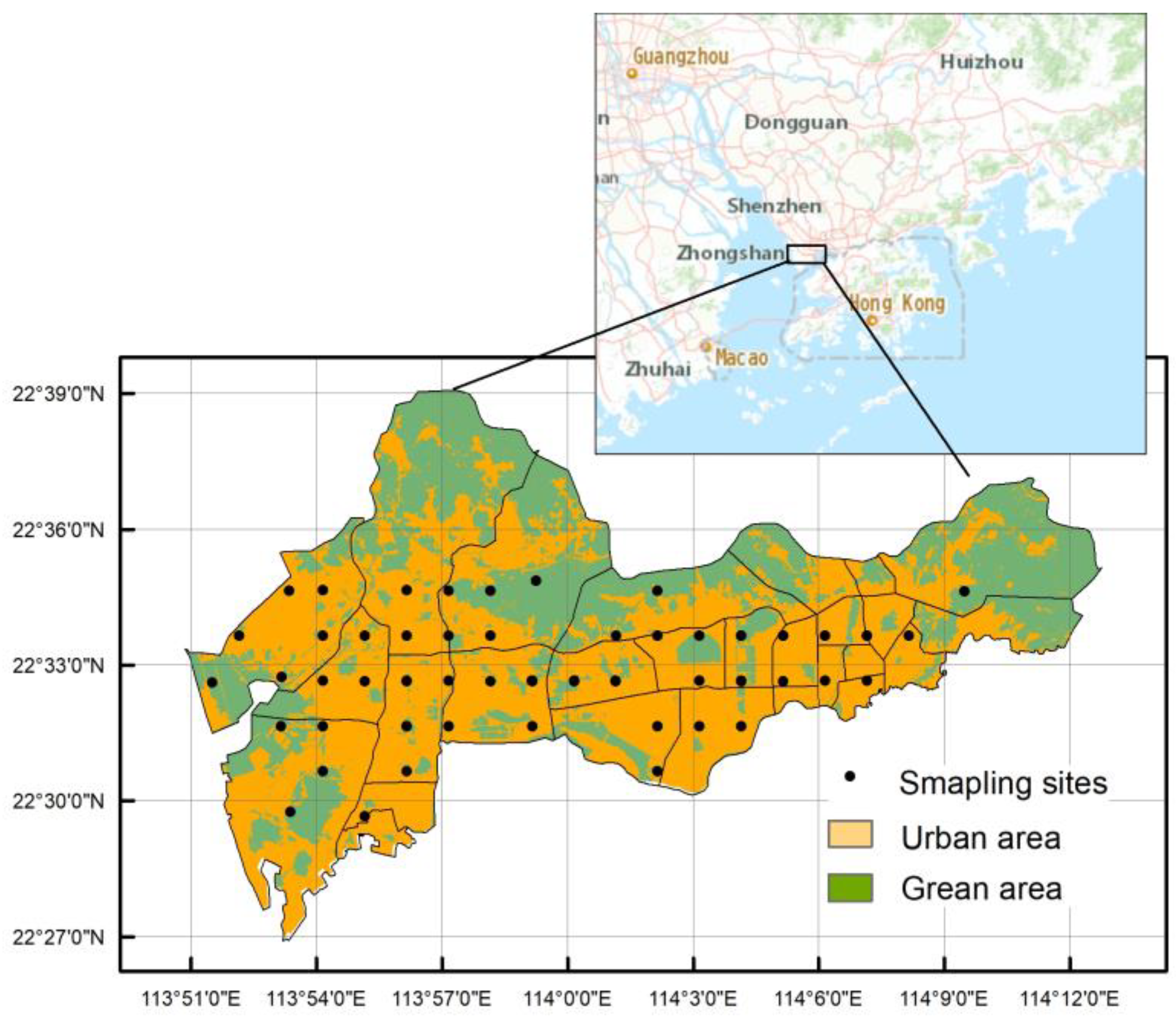
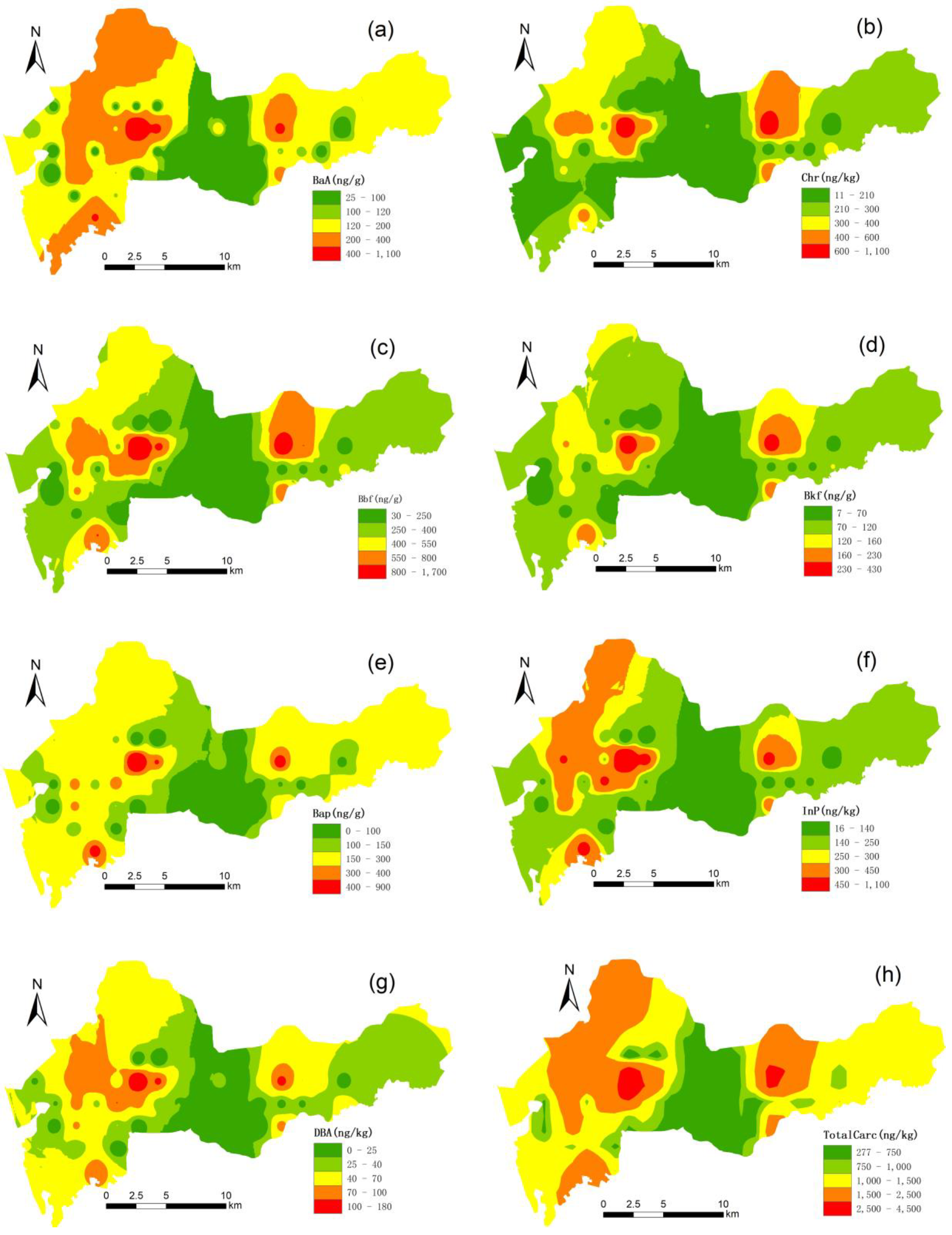
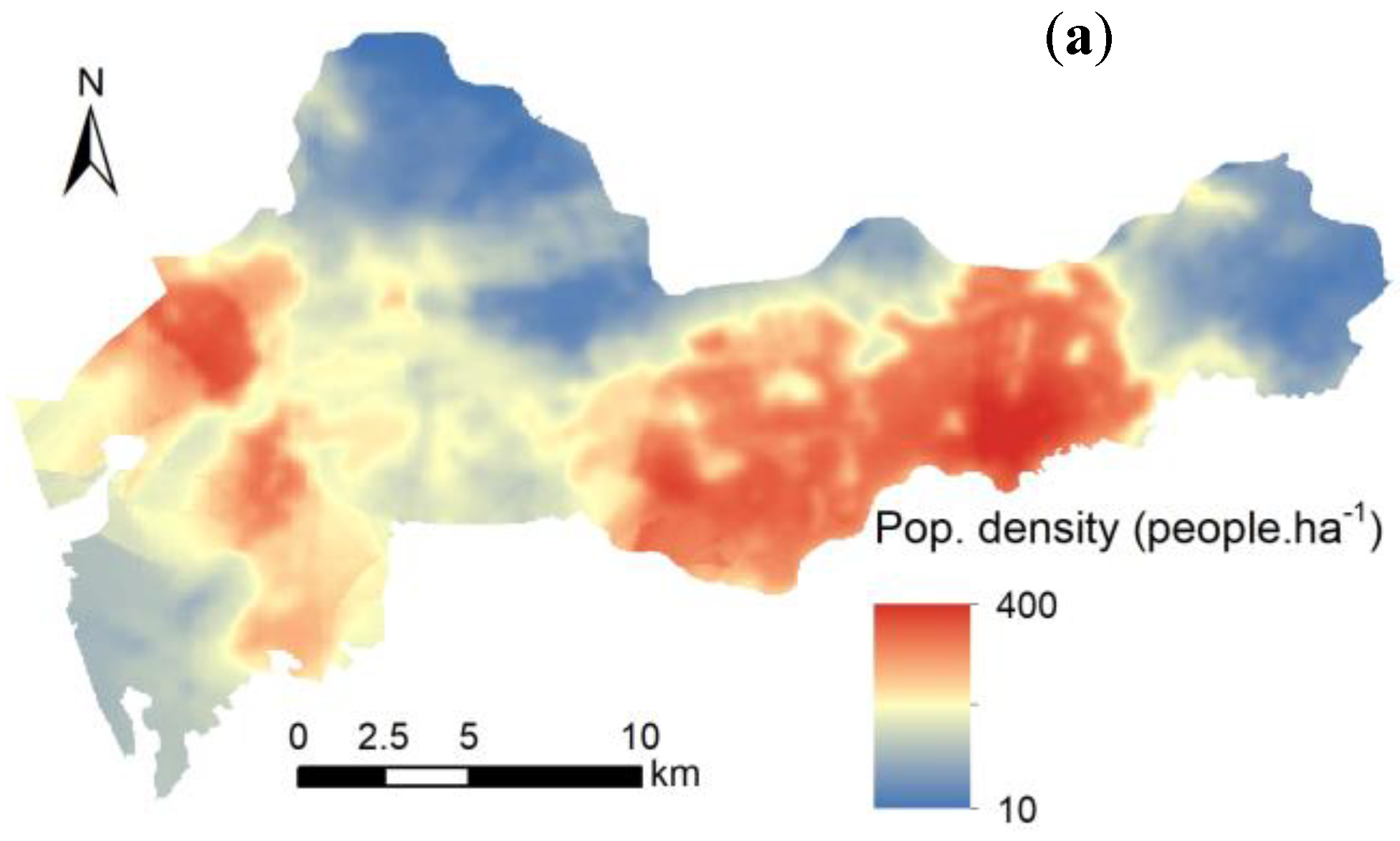
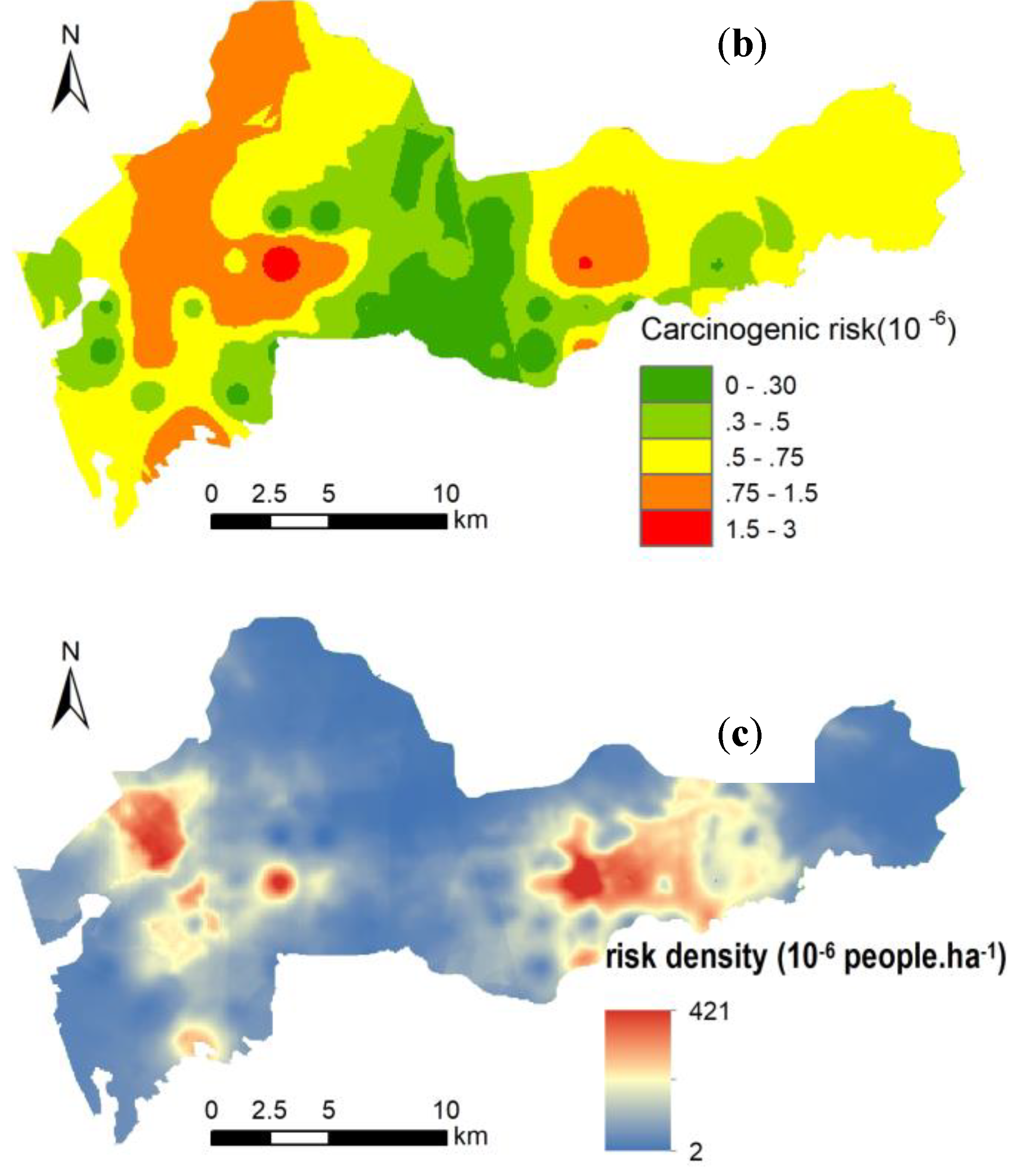
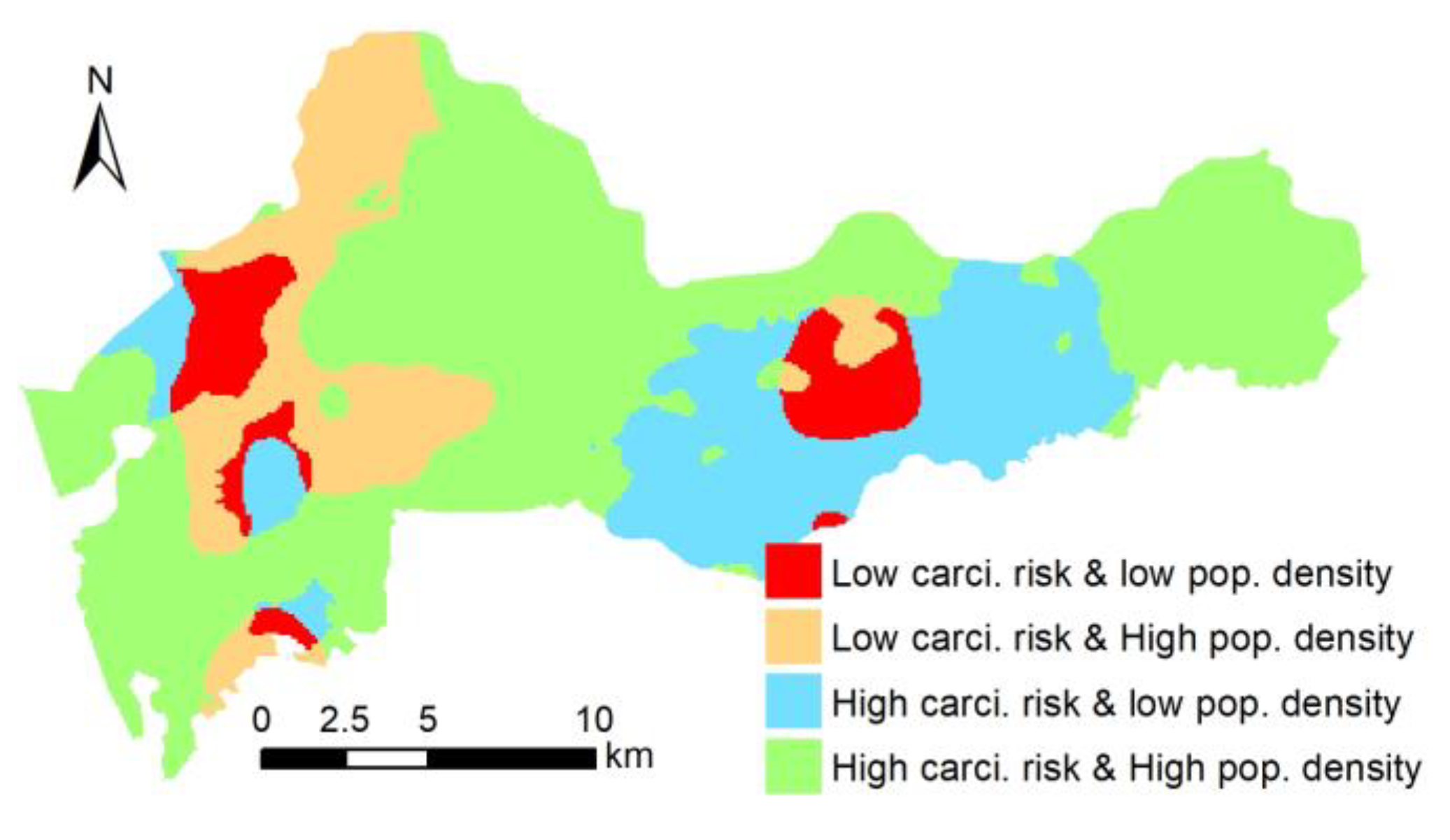
| PAH | BaA | Chr | BbF | BkF | BaP | InP | DBA |
|---|---|---|---|---|---|---|---|
| TEF value | 0.1 | 0.01 | 0.1 | 0.1 | 1 | 0.1 | 1 |
| Parameters | Unit | Value |
|---|---|---|
| average bodyweight (ABW) | kg | 58.55 |
| exposure frequency (EF) | day year−1 | 365 |
| Exposure duration(ED) | year | 24 |
| daily inhalation rate (IR inhalation) | m3 day−1 | 13.04 |
| daily ingestion rate(IR ingestion) | mg day−1 | 100 |
| dermal surface area(SA) | cm2 day−1 | 5700 |
| soil adhesion factor(AF) | mg cm−2 | 0.07 |
| dermal absorption coefficient(ABS) | 0.13 | |
| life expectancy(AT) | day | 80 × 365 |
| production factor of soil dust(PEF) | m3 kg−1 | 1.36 × 109 |
| carcinogenic slope factor of ingestion(CSF ingestion) | (mg kg−1 day−1)−1 | 7.3 |
| carcinogenic slope factor inhalation(CSF inhalation) | (mg kg−1 day−1)−1 | 3.85 |
| carcinogenic slope factor dermal exposures (CSF dermal) | (mg kg−1 day−1)−1 | 25 |
| Order | Risk Threshold | Population Density (People ha−1) | Risk Management Zones |
|---|---|---|---|
| 1 | >10−6 | >200 | High risk with high pop.Dens |
| 2 | >10−6 | <200 | High risk with low pop.Dens |
| 3 | <10−6 | >200 | low risk with high pop.Dens |
| 4 | <10−6 | <200 | low risk with low pop.Dens |
| High-Density Urban (ng g−1) | Green Area (ng g−1) | |||||||
|---|---|---|---|---|---|---|---|---|
| PAHs | Min | Max | Mean | SD | Min | Max | Mean | SD |
| Nap | 11.16 | 57.29 | 24.07 | 9.78 | 6.37 | 35.62 | 18.82 | 7.80 |
| Acy | 0.69 | 35.17 | 5.96 | 6.50 | 0.89 | 7.78 | 3.81 | 2.45 |
| Ace | ND | 7.70 | 1.68 | 1.37 | 0.50 | 3.71 | 1.36 | 0.95 |
| Fl | 1.92 | 17.97 | 6.86 | 3.06 | 2.78 | 9.79 | 5.40 | 2.06 |
| Phe | 13.64 | 184.79 | 47.25 | 31.20 | 12.78 | 75.32 | 36.43 | 17.30 |
| Ant | 1.28 | 27.13 | 6.39 | 5.60 | 1.20 | 8.68 | 4.41 | 2.65 |
| Flu | 10.79 | 355.82 | 65.09 | 68.33 | 9.59 | 82.19 | 38.70 | 22.75 |
| Pyr | 8.69 | 345.27 | 54.45 | 59.76 | 7.88 | 81.00 | 34.85 | 21.30 |
| BaA | 3.30 | 217.21 | 33.99 | 37.40 | 3.96 | 63.58 | 24.35 | 17.29 |
| Chr | 3.30 | 217.78 | 54.28 | 49.25 | 2.24 | 97.77 | 40.23 | 28.01 |
| BbF | 5.91 | 336.82 | 76.12 | 73.35 | 5.68 | 184.93 | 60.56 | 49.17 |
| BkF | 1.28 | 85.50 | 20.17 | 19.42 | 1.21 | 38.94 | 14.83 | 10.60 |
| BaP | 2.45 | 171.87 | 34.22 | 33.58 | ND | 94.62 | 28.97 | 24.28 |
| InP | 3.47 | 210.55 | 43.58 | 41.48 | 3.11 | 119.95 | 36.67 | 31.64 |
| DBA | 0.25 | 35.23 | 9.30 | 8.22 | ND | 25.36 | 7.84 | 6.92 |
| BP | 3.25 | 169.35 | 42.90 | 37.06 | 1.22 | 102.71 | 39.04 | 31.74 |
| ∑PAHs | 92.84 | 2309.88 | 526.32 | 457.12 | 73.47 | 985.05 | 396.27 | 262.44 |
| ∑PAHscarc | 24.45 | 1274.96 | 271.67 | 255.35 | 24.70 | 616.27 | 213.45 | 164.43 |
| Exposure Pathway | Min | Max | Mean |
|---|---|---|---|
| ILCRdermal | 1.4 × 10−8 | 1.78 × 10−6 | 3.57 × 10−7 |
| ILCRingestion | 7.9 × 10−9 | 1.1 × 10−6 | 2.01 × 10−7 |
| ILCRinhalation | 4 × 10−13 | 5.08 × 10−11 | 1.02 × 10−11 |
| Total exposure (CR) | 2.19 × 10−8 | 2.79 × 10−6 | 5.58 × 10−7 |
© 2020 by the authors. Licensee MDPI, Basel, Switzerland. This article is an open access article distributed under the terms and conditions of the Creative Commons Attribution (CC BY) license (http://creativecommons.org/licenses/by/4.0/).
Share and Cite
Chen, D.; Zhao, H.; Zhao, J.; Xu, Z.; Wu, S. Mapping the Finer-Scale Carcinogenic Risk of Polycyclic Aromatic Hydrocarbons (PAHs) in Urban Soil—A Case Study of Shenzhen City, China. Int. J. Environ. Res. Public Health 2020, 17, 6735. https://doi.org/10.3390/ijerph17186735
Chen D, Zhao H, Zhao J, Xu Z, Wu S. Mapping the Finer-Scale Carcinogenic Risk of Polycyclic Aromatic Hydrocarbons (PAHs) in Urban Soil—A Case Study of Shenzhen City, China. International Journal of Environmental Research and Public Health. 2020; 17(18):6735. https://doi.org/10.3390/ijerph17186735
Chicago/Turabian StyleChen, Dongxiang, Han Zhao, Jun Zhao, Zhenci Xu, and Shaohua Wu. 2020. "Mapping the Finer-Scale Carcinogenic Risk of Polycyclic Aromatic Hydrocarbons (PAHs) in Urban Soil—A Case Study of Shenzhen City, China" International Journal of Environmental Research and Public Health 17, no. 18: 6735. https://doi.org/10.3390/ijerph17186735
APA StyleChen, D., Zhao, H., Zhao, J., Xu, Z., & Wu, S. (2020). Mapping the Finer-Scale Carcinogenic Risk of Polycyclic Aromatic Hydrocarbons (PAHs) in Urban Soil—A Case Study of Shenzhen City, China. International Journal of Environmental Research and Public Health, 17(18), 6735. https://doi.org/10.3390/ijerph17186735




